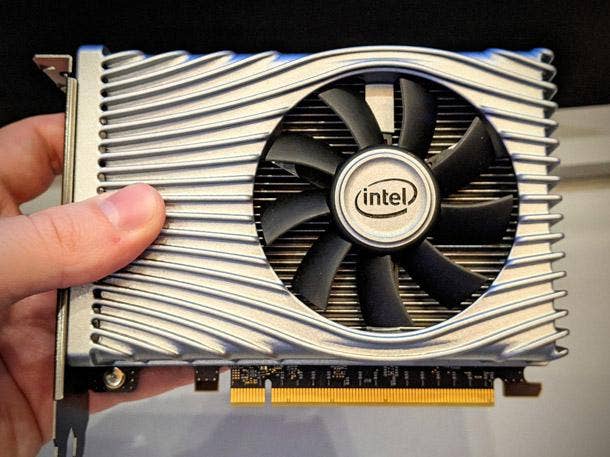Intel Is Sampling A DG1 GPU 'Software Development Vehicle' With ISVs
'Another purpose of DG1 is it's a software development vehicle for us. That's going to help Tiger Lake, DG1 and lots of other Xe-based products that come after it,' Intel's Darren McPhee says of the the chipmaker's GPU development efforts.

Intel said software developers have begun receiving a special version of its first discrete graphics card, code-named DG1, to prepare for the debut of the chipmaker's Xe GPU architecture later this year.
In a briefing with journalists at CES in Las Vegas on Wednesday, Intel executive Ari Rauch stressed that the graphics card being sent to developers is a "software development vehicle" and not a product that represents what consumers should expect when the company releases its first discrete GPU — which Intel revealed as a graphics card for laptops under the code name DG1 at its press conference Monday.
"We are very happy with where we are, but it's still a very early development platform that we wanted to share with you today," said Rauch, whose titles are vice president of Intel Architecture, Graphics and Software and general manager of the Visual Technologies team and Graphics Business.
[Related: Next For AMD In The Data Center: Tighter EPYC-Radeon Integration]
The purpose of the DG1 special development vehicle is to encourage developers — whether they're making PC games, content creation programs or other kinds of applications — to optimize their software for Intel's upcoming Tiger Lake mobile processors and DG1, which will use the company's new Xe GPU architecture for integrated graphics and discrete graphics, respectively.
"Another purpose of DG1 is it's a software development vehicle for us," said Darren McPhee, Intel's director of product marketing for discrete graphics. "That lets us put Xe architecture in the hands of game developers and application developers and start to get the wheels turning for Xe. That's going to help Tiger Lake, DG1 and lots of other Xe-based products that come after it."
When independent software developers (ISVs) receive the DG1 software development vehicle, it will come in a special development desktop PC the company has made. During the press briefing, an Intel representative showed the development system playing the PC game Warframe.

McPhee said that while the DG1 software development vehicle is an important step for optimizing software for its upcoming Xe graphics technology, it's just one piece of the puzzle.
"We have a world-class developer relations team. They're engaging with the developers," he said. "We have ISV engineers, so the things that you're thinking a world-class company should do, that's what we're doing. This is just one part of that bigger picture."
Rauch said a "substantial" number of ISVs are receiving the DG1 software development vehicle this year.
"I want to get the users from day one the best experience," he said.
Intel's reveal of Tiger Lake and DG1 on Monday was a major milestone for the company after it hired Raja Koduri, AMD's former chief GPU architect, in 2017 to lead Intel's effort to enter the discrete GPU space — an area in which the company has made previous attempts but failed.
The company has shared a few details about Tiger Lake and DG1 at CES. That includes a promised double-digit graphical performance boost in Tiger Lake over Intel's current-generation Ice Lake chips for laptops as well as DG1's dynamic tuning features for power efficient platforms. But company officials on Wednesday declined to say much more beyond what was presented earlier in the week.
When asked if Intel is on track to release its first discrete GPU in 2020 — a target the company has previously stated — Rauch declined to say.
"We are not sharing exact timing, but we are on track to our plans that we set for ourselves," he said.
The company has confirmed, however, that laptops running Tiger Lake processors with integrated Xe graphics are expected to start shipping later this year.
While the company has provided integrated graphics in its CPUs for decades, the new Xe architecture represents a new effort for the company to not just improve its graphics capabilities but also build discrete GPUs, which are a separate component from the CPU, for a variety of market segments.
Intel has previously disclosed that it is developing microarchitectures from Xe to address those different segments along a spectrum. For instance, the Xe HPC microarchitecture will address HPC, deep learning training and cloud graphics while Xe LP, or low power, will address gaming, PC mobile and ultra-mobile devices. In between those two segments is Xe HP, or high performance, which will also address gaming and cloud graphics as well as media transcode analytics and workstation.
In November, the company shared details of its first discrete GPU for HPC and deep learning, code-named Ponte Vecchio, that will make it into the U.S. Department of Energy's Aurora supercomputer, which is set for a 2021 launch.
"This week, we are actually talking much more about our Xe LP, low power," Rauch said, "which is basically trying to address the ultra-mobile, the next generation in Tiger Lake and in DG1, leveraging the common architecture there that is really optimizing to deliver peak performance in a power-constrained envelope, and we will share much more as we move forward."